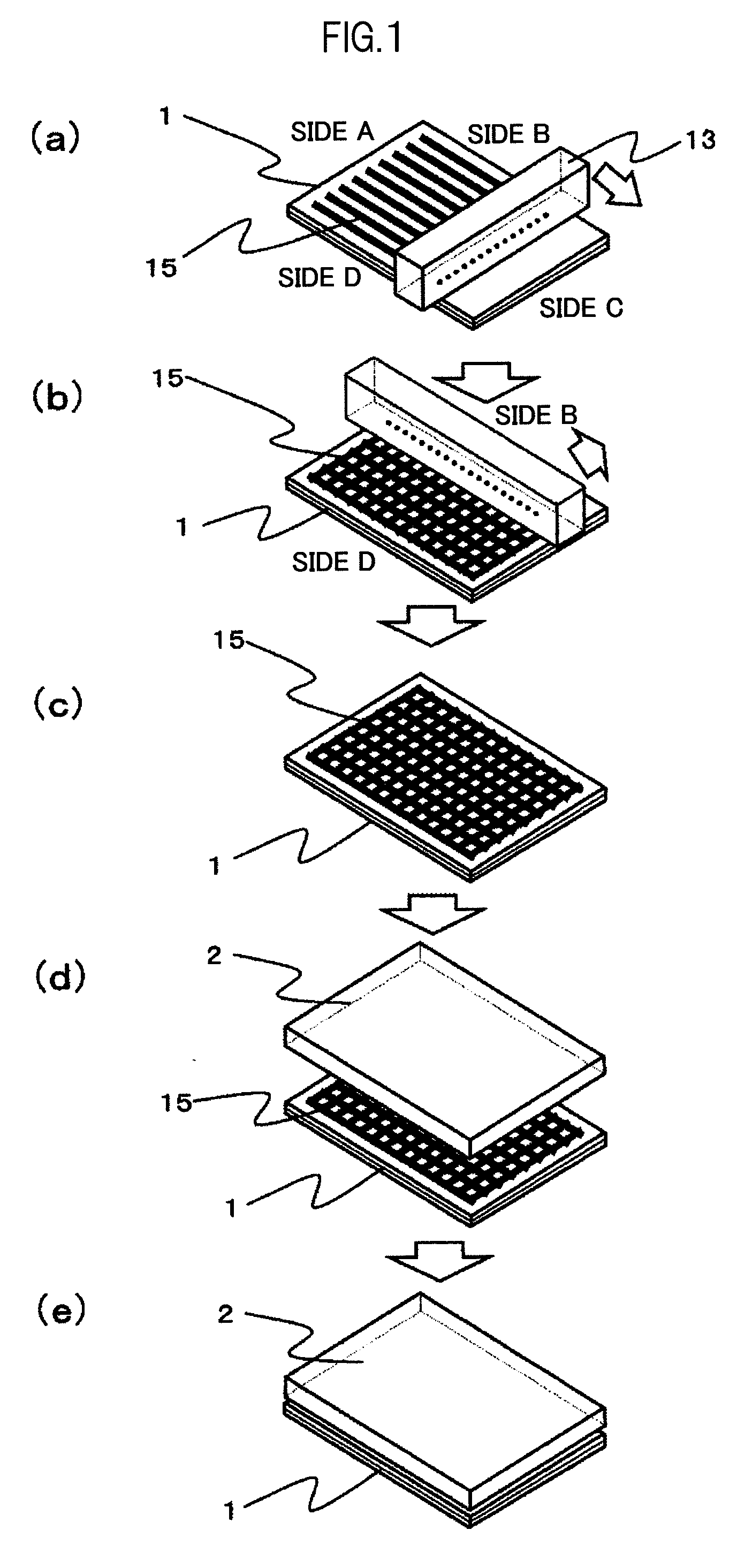Method of manufacturing a display
a display and manufacturing method technology, applied in non-linear optics, instruments, chemistry apparatuses and processes, etc., can solve the problems of high interlayer bonding, affecting the visibility of displayed images, and the liquid crystal panel itself could be shattered, so as to keep the equipment cost necessary for the manufacture low, the effect of short tim
- Summary
- Abstract
- Description
- Claims
- Application Information
AI Technical Summary
Benefits of technology
Problems solved by technology
Method used
Image
Examples
first embodiment
[0086]A first embodiment of the present invention is described with reference to FIGS. 1A to 1E. First, the multi-application nozzle 13 is used to apply the liquid organic medium 15 to a surface of the liquid crystal display panel 1 from Side A to Side C (or from Side C to Side A; either way, the direction does not matter) in a stripe pattern (FIG. 1A). Next, the liquid organic medium 15 is applied to the same surface of the liquid crystal display panel 1 from Side D to Side B (or from Side B to Side D; either way, the direction does not matter) in a stripe pattern that intersects the previously formed stripe application pattern (FIG. 1B). A grid pattern illustrated in FIG. 1C is thus formed. Although FIGS. 1A to 1C illustrate a method of using the multi-application nozzle 13 to form a grid-like application pattern, the grid-like application pattern may be formed by screen printing or offset printing as described in [Liquid Organic Medium Application Methods].
[0087]Next, the protect...
second embodiment
[0089]A second embodiment of the present invention is described with reference to FIGS. 6A to 6F. First, the multi-application nozzle 13 is used to apply the liquid organic medium 15 to a surface of the liquid crystal display panel 1 from Side A to Side C (or from Side C to Side A; either way, the direction does not matter) in a stripe pattern (FIGS. 6A and 6B). Next, the multi-application nozzle 13 is used to apply the liquid organic medium 15 to a surface of the protective plate 2 from Side D to Side B (or from Side B to Side D; either way, the direction does not matter) in a stripe pattern (FIGS. 6C and 6D). Although FIGS. 6A to 6D illustrate a method of using the multi-application nozzle 13 to form a stripe application pattern, the stripe application pattern may be formed by screen printing or offset printing as described in [Liquid Organic Medium Application Methods].
[0090]Next, the protective plate 2, where the liquid organic medium 15 has been formed in a stripe pattern, is p...
third embodiment
[0092]A third embodiment of the present invention is described with reference to FIG. 7. First, a slit application nozzle 14 is used to apply the liquid organic medium 15 solidly to a surface of the liquid crystal display panel 1 from Side D to Side B (or from Side B to Side D, from Side A to Side C, from Side C to Side A; any way, the direction does not matter) (FIGS. 7A and 7B).
[0093]Next, the multi-application nozzle 13 is used to apply the liquid organic medium 15 to a surface of the protective plate 2 from Side A to Side C (or from Side C to Side A; either way, the direction does not matter) in a stripe pattern (FIG. 7C). The liquid organic medium 15 is then applied to the same surface of the protective plate 2 from Side D to Side B (or from Side B to Side D; either way, the direction does not matter) in a stripe pattern that intersects the previously formed stripe application pattern (FIG. 7D). A grid pattern illustrated in FIG. 7E is thus formed.
[0094]Thereafter, the protecti...
PUM
| Property | Measurement | Unit |
|---|---|---|
| refractive index | aaaaa | aaaaa |
| width | aaaaa | aaaaa |
| thickness | aaaaa | aaaaa |
Abstract
Description
Claims
Application Information
 Login to View More
Login to View More - R&D
- Intellectual Property
- Life Sciences
- Materials
- Tech Scout
- Unparalleled Data Quality
- Higher Quality Content
- 60% Fewer Hallucinations
Browse by: Latest US Patents, China's latest patents, Technical Efficacy Thesaurus, Application Domain, Technology Topic, Popular Technical Reports.
© 2025 PatSnap. All rights reserved.Legal|Privacy policy|Modern Slavery Act Transparency Statement|Sitemap|About US| Contact US: help@patsnap.com



